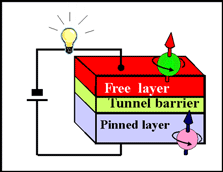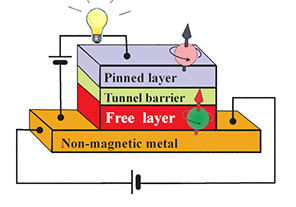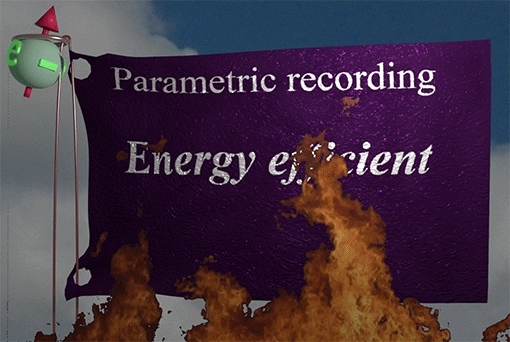Parametric mechanism of Magnetization Reversal.
Parametric parameter 3: Spin Injection.
Spin and Charge Transport
Abstract:
The magnetization of nanomagnet can be reversed by a flow of a spin-polarized current. However, such magnetization reversal mechanism requires a substantial amount of the spin injection and, therefore, a substantial electrical current. In contrast, the parametric mechanism of magnetization reversal requires a significantly smaller amount spin injection and, therefore, the electrical current for the magnetization reversal due to its resonance nature.
When the electrical current and, therefore, the spin injection are modulated at a frequency close the resonance frequency ωL of the magnetization precession (Larmor frequency), a small spin injection resonantly enhances the magnetization precession, which leads to the magnetization reversal.
In a magneto- resistive structure the magnetization can be effectively reversed even by a DC current due to a parametric resonance. A random thermal oscillation of magnetization modulates the electrical current due to the magneto-resistance. The current, which is modulated precisely at the Larmor frequency, parametrically enhances the magnetization precession, which causes even larger current modulation. Due to this positive feedback loop, the parametric magnetization reversal requires a substantially smaller amount of spin injection than the direct reversal by spin injection.
page creation date: start May 2021-
Content
1.
 .........
......... 
details about this mechanism of the parametric magnetization reversal can be found here  V. Zayets arXiv:2104.13008 (2021)
V. Zayets arXiv:2104.13008 (2021)
(Part 1 is here): General principles of Parametric mechanism of Magnetization Reversal.
(Part 2 is here): Parameter of parametric resonance: Current- induced magnetic field.
(Part 3 is here): Parameter of parametric resonance: Anisotropy field.
(Part 4 is here): Parameter of parametric resonance: Amount of spin injection.
Conventional MRAM recording method utilizing spin injection
Spin Transfer Torque (ST) & Spin Orbit Torque (SOT)
Recording methods of MRAM cell |
| Conventional methods, which utilize spin-injection |
Spin Transfer Torque
2-terminal MRAM cell |
Spin Orbit Torque
3-teminal MRAM cell |
 |
 |
| Fig.1a. Under applied voltage, the spin- polarized conduction electrons flows from the "pin" layer to "free" layer creating the spin-torque. When the spin torque is sufficient, the magnetization of the "free" layer is reversed and is data is recorded. |
Fig.1b. The writing current flows through the non-magnetic metal. The spin current is generated at free-layer/ non-magnetic-metal interface, which reverses the magnetization of the free-layer and a data is recorded. |
|
| |
| MTJ consists of of a "pin" and "free" ferromagnetic layers separated by a thin isolator. The magnetic anisotropy of the "pin" layer is large and its magnetization direction is firmly fixed. The magnetic anisotropy of the "free" layer is smaller and its magnetization direction can be changed by spin injection from the "pin" layer. Data are stored in the MRAM cell by means of two stable magnetization directions of the "free" layer. |
| MTJ is used as a memory cell in Magnetic Random Access Memory |
| click on image to enlarge it |
Magnetization reversal by an electrical current is used as a writing mechanism for a Magnetic Random Access Memory (MRAM). A cell of the MRAM memory consists of a "pin" and "free" ferromagnetic layers. The magnetic anisotropy of the "pin" layer is large and its magnetization direction is firmly fixed. The magnetic anisotropy of the "free" layer is smaller and its magnetization direction can be changed by spin injection from the "pin" layer. Data are stored in the MRAM cell by means of two stable magnetization directions of the "free" layer.
There are two types of MRAM design: 2-terminal and 3- terminal MRAM. The writing mechanism is different for each MRAM type.
(2-terminal MRAM & Spin Transfer Torque) (recording principle): the writing electrical current flows through the interface between the "pin" and the "free" layers. The electrical current is spin-polarized and carries the spin-polarized conduction electrons from the "pin" layer into the "free" layer. As a result, the spin direction of spin-polarized electrons in the "free" layer is changed. When the spin injection is sufficient the magnetization of the "free" layer is reversed and the data is memorized3-5. This effect of magnetization reversal is called the Spin Transfer Torque .
(recording principle): the writing electrical current flows through the interface between the "pin" and the "free" layers. The electrical current is spin-polarized and carries the spin-polarized conduction electrons from the "pin" layer into the "free" layer. As a result, the spin direction of spin-polarized electrons in the "free" layer is changed. When the spin injection is sufficient the magnetization of the "free" layer is reversed and the data is memorized3-5. This effect of magnetization reversal is called the Spin Transfer Torque .
(3-terminal MRAM & Spin Orbit Torque) (recording principle): the writing electrical current flows only inside the "pin" layer along its interface with the "free" layers. Due to the spin-dependent scattering at the interface, the spin-polarized electrons are accumulated at the interface and diffuse deep into the "free" layer. The diffused spin- polarized electrons create the spin torque, which may reverse the magnetization of the "free" layer. The spin accumulation is particularly effective at heave metal/ ferromagnetic metal interface. This effect is called the Spin- Orbit Torque (SOT)6,7.
(recording principle): the writing electrical current flows only inside the "pin" layer along its interface with the "free" layers. Due to the spin-dependent scattering at the interface, the spin-polarized electrons are accumulated at the interface and diffuse deep into the "free" layer. The diffused spin- polarized electrons create the spin torque, which may reverse the magnetization of the "free" layer. The spin accumulation is particularly effective at heave metal/ ferromagnetic metal interface. This effect is called the Spin- Orbit Torque (SOT)6,7.
(Merit of 3-terminal MRAM vs 2-terminal MRAM):  Avoidance of a large current flow through the tunnel junction at the interface between “pin” and “free” layers during a writing event is the main merit of the 3-termianal MRAM, which greatly improves its durability and reliability.
Avoidance of a large current flow through the tunnel junction at the interface between “pin” and “free” layers during a writing event is the main merit of the 3-termianal MRAM, which greatly improves its durability and reliability.
 |
Parametric recording is an energy- efficient recording mechanism |
| click on image to enlarge it |
Comparison of Conventional MRAM Recording methods and Parametric recording method 

 Conventional MRAM Recording (Spin Orbit Torque & Spin Orbit Torque):
Conventional MRAM Recording (Spin Orbit Torque & Spin Orbit Torque):
(merit)  Simpler design & no optimization is required
Simpler design & no optimization is required
(demerit)  high recording current & moderate energy efficiency for recording
high recording current & moderate energy efficiency for recording
 Parametric MRAM Recording:
Parametric MRAM Recording:
(merit)  low recording current & good energy efficiency for recording
low recording current & good energy efficiency for recording
(demerit)  subtle optimizations of materials and structure design are required
subtle optimizations of materials and structure design are required
Spin injection 
 for parametric magnetization reversal
for parametric magnetization reversal
(key property of spin injection for parametric magnetization reversal)  Current-induced magnetic field H(CI) modulates magnetization direction
Current-induced magnetic field H(CI) modulates magnetization direction
(RF modulated current: parametric resonance) When frequency and phase of the electrical current in the resonance with the magnetization precession, the modulation of H(CI) leads to enhancement of magnetization oscillations and further to the magnetization reversal (See details below)
When frequency and phase of the electrical current in the resonance with the magnetization precession, the modulation of H(CI) leads to enhancement of magnetization oscillations and further to the magnetization reversal (See details below)
(DC electrical current: positive feedback loop)  Under a DC current a thermally- initiated magnetization oscillation is enhanced to a substantial magnetization precession and further to the magnetization reversal due to positive feedback loop. The positive feedback loop is: (1) a small magnetization precession---> (2) modulation of the magneto- resistance ---> (3) modulation of electrical current ---> (4) modulation of the current-induced magnetic field H(CI) ---> (5) parametric enhancement of magnetization precession ---> (6) magnetization precession at a larger precession angle ---> (2) --->(3) ---> (4) ---> (5) --->(6) --> (2)
Under a DC current a thermally- initiated magnetization oscillation is enhanced to a substantial magnetization precession and further to the magnetization reversal due to positive feedback loop. The positive feedback loop is: (1) a small magnetization precession---> (2) modulation of the magneto- resistance ---> (3) modulation of electrical current ---> (4) modulation of the current-induced magnetic field H(CI) ---> (5) parametric enhancement of magnetization precession ---> (6) magnetization precession at a larger precession angle ---> (2) --->(3) ---> (4) ---> (5) --->(6) --> (2)

 I am strongly against a fake and "highlight" research
I am strongly against a fake and "highlight" research 






